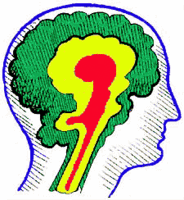 by Flemming Funch by Flemming Funch
From "Spiritual Emergency and the Triune Brain" by Grant McFetridge, here's a good description of the three parts of the human brain.
We start with a simplified version of the triune brain model, one without any controversial transpersonal elements, yet which is adequate for working with a number of spiritual emergence categories. A very neglected breakthrough in understanding brain biology forms the basis for this model. In the 1960’s Dr. Paul MacLean at the National Institute for Mental Health, expanding on the work of James Papez, described a three part concentric layering structure to the human brain. The outermost layer is the neomammilian brain, the neocortex which is the seat of thought and most voluntary movement. The next layer inward is the paleomamalian brain, composed of the limbic system, the seat of our emotions and autonomic nervous system. In the innermost portion is found the reptilian brain, composed of the the brain stem, midbrain, basal ganglia and other structures. Each brain serves different functions with some overlap, but what Dr. MacLean postulates is that the integration, or coordination between the brains is inadequate, a genetic problem in our species. For more information, see Evolutions End by Joseph Pierce, Three Faces of the Mind by Elaine De Beauport, and for summary information see Maps of the Mind by Charles Hampden-Turner. For a complete biological description see Dr. MacLean’s The Triune Brain in Evolution: Role in Paleocerebral Functions.
How does the triune structure of the brain apply to our inner experience? In everyday terms, we know these brains as the ‘mind’, ‘heart’, and ‘body’. Each brain has different biological functions and abilities. The ‘mind’, or neocortex, is the part of ourselves we most often think of as who we are. It perceives itself in the head, and it is the part of ourselves that forms judgments, handles short term memory, and does abstractions like mathematics. The ‘heart’ is the limbic system in the brain, yet perceives itself in the chest, probably because this is the area of it’s primary biological responsibility and sensory awareness. It allows us to feel emotions, and be either positively or negatively emotionally aware of the presence of others. Finally, the ‘body’ consciousness (or ‘hara’ in Japanese) is composed of the tissues at the base of our skulls, and probably other distributed systems in our body. It experiences itself in the lower belly, it’s area of major biological function. This brain gives us a sense of time and our ability to feel sexuality. We communicate with this brain when we do dowsing or muscle testing.
The most difficult conceptual jump in Dr. MacLean’s work is to realize that each of the brains is intelligently, independently self aware. Because we tend to assume thinking requires words, it’s difficult for us to realize that each brain actually thinks. In fact, unlike the mind, the heart thinks in sequences of feelings, and the body thinks in gestalt sequences of body sensations (described as the ‘felt sense’ in Eugene Gendlin’s Focusing). By this, I don’t mean that it’s as if there were three people inside of us. Instead, since each brain is so different, we might compare this situation to that of a living stereo system. Imagine if the speakers (mind), tape deck (heart), and receiver (body) were each self aware, each trying to run the show and puzzled because the other parts won’t do what they want them to. It would be hard to imagine how a stereo like this would ever manage to play music! And unfortunately, this is fairly close to the mark. Even though sharing much sensory data and awareness of each other’s actions, each brain tends to be in denial about the existence of the others. In fact, the brains often come into conflict, even to the point of overtly or unconsciously attempting to manipulate and control each other. A simple example to illustrate this occurs when you’re sexually attracted (the body consciousness) to someone you don’t even like (the emotional consciousness). Obviously, many of our problems in the world can be explained by that split, and the failure of our different parts to be in synch with each other. And, obviously, the answer is to work towards better integration and coordination. Not that I actually believe I really AM any of those parts of the brain, or that my consciousness originates in the brain. But they nevertheless represent a split between different types of consciousness that really ought to work together. And they represent aspects we need to encompass. Doesn't work if one identifies oneself only with one's mental thoughts, and believes that the other parts are inferior. In many ways they're more capable than the conscious mental faculties, which tend to make many mistakes, and which are prone towards arrogance.
|
|
 by Flemming Funch
by Flemming Funch